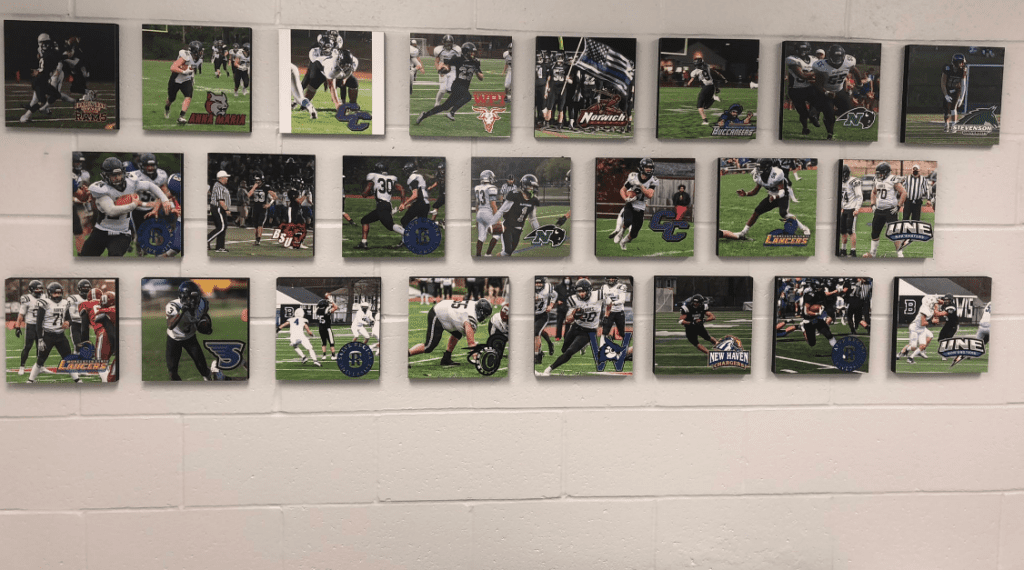Every young football player’s goal is to get into the NFL. While the odds are extremely low of actually getting to the NFL, playing college football is more likely.
Football can help change lives. Athletes from all backgrounds can earn scholarships to prestigious universities and pay next to nothing for college.
In order to get a scholarship, you need to make sure all the right pieces are in place. In this article, we’re going to show you everything that you need to know to help your child get a scholarship to play football.
To date, we’ve helped place 30 high school athletes into college at the high school I coach at (Bellingham High School in Massachusetts). Here is a picture of all of the athletes that we recognize on our office wall (missing is the class of 2022 & 2023).
In this article, we’re going to show you how to get recruited for college football and how to contact college coaches.
We’ve helped players from all walks of life get into college. This means poor, rich, two-parent households, single families, etc.
How To Get Recruited To Play College Football
Have Athletic Ability & Size
The first way to get a scholarship from a college is to have athletic ability and size. Most of this is completely out of our control, but it does play a major factor. Colleges typically have size and skill set criteria for each position at the Division 1 level.
For example, outside wide receivers (X receivers) at the Division 1 level are typically over 6’0 tall. This is so teams who need to throw the ball down the field, can win the “jump ball” situations against more athletic cornerbacks.
If you’re 5’6, there is a good chance you may not win those types of throws, no matter how fast you are. This is why coaches will often seek out taller players for that specific position.
Speed is also a major factor in playing college football. If you’re a defensive player, you will need to be able to run with faster offensive players. Coaches will heavily rely on combine drills such as the 40-yard dash for speed as well as 5-10-5 times for change of direction.
If you score poorly in these categories, it can immediately turn a coach off. Remember there are thousands of athletes that college recruit every year. You need to stand out from the other players they are recruiting.
See the full list of recommended height and weight guidelines here at NCSAsports.org.
Do Well In School
The next major factor is grades. If your child has poor grades, then the chances of getting a scholarship are extremely rare.
Why is this such a major factor? Dependability.
If you are not reliable to get your work done in high school, colleges (as well as the coaches) will look at you as a liability. What if you fail out? What if you’re not able to do your work and need to miss practice time?
If there are too many “what ifs” off the field, a coach won’t be able to trust you on the field.
The goal I always have for my athletes is to get above a 3.0. We want to shoot for a 4.0 but above a 3.0 should be the bare minimum.
If your GPA is below 3.0, that is when the doors start to close on some bigger named colleges. The higher your grades, the more doors will open for you.
Test Scores
Most schools nowadays are test-optional (meaning they don’t require you to take standardized tests), however, it’s important that your child does take them and scores well on the SAT and the ACT tests.
Our best advice is to contact the school or coach directly of the schools you’re interested in, and ask them if they are “test-optional”. This will help you gauge if your player needs to take them or not.
We recommend taking them and if you score poorly, you can just not submit them to test-optional schools. If you do well, it can really help your case to get into the school.
Taking Proper Classes
Having 3 study periods and gym class may be fun for your child, but it’s not helping their GPA.
Colleges want to see that your son or daughter is challenging themselves to get better. Although chemistry might be hard, it shows that you’re trying to challenge yourself.
Also, there are some engineering schools and business schools that won’t accept you unless you take pre-calculus or other math-related courses.
Depending on your major, it’s always good to check with the coach and the college to see the prerequisites of what it takes to get into the college’s program.
Create A Highlight Reel
The next step is to create a highlight reel.
A highlight reel is a compilation of plays from the previous season strung together into one, easily digestible video.
For high schools that use Hudl, it’s super easy to make a highlight tape. We recommend you follow the instructions here, in order to make your highlight tape on Hudl.
A few notes on creating a highlight reel:
- Start the highlight with your name, position, stats, any awards that you have won, and contact information.
- Put your biggest plays first. Let the coach know how explosive of an athlete you are right at the beginning
- Make it 4-6 minutes long. Remember, coaches value their time because they have other players’ films to go through. If your highlight tape is 15 minutes long, they are not going to go through the entire film.
- Put relevant plays on your film. If you make a big hit, but it’s a penalty, coaches don’t care. Make sure the plays are relevant to the game of football and showcase your talents.
Here is an example of one of my current player’s highlight reels that you can copy: https://www.hudl.com/video/3/14146201/63812e38f326f607201f379b
Build A Social Profile For College Football Coaches
The best way to contact coaches is on Twitter.
If you do not have a Twitter account, we highly recommend that you create one right now. Every college coach recruits potential college football players on Twitter. It’s their direct line to contact players.
I have created guidelines for my players, that your child can copy to set up their Twitter profile. See the image below.
If you notice, any college coach who visits Gavin’s profile has everything they need in one glimpse. This is how your profile bio should look.
A few things to note:
- The school is listed first, so the coach knows exactly where you play and what year you graduate.
- Position, height, and weight are listed clearly.
- The GPA at the current time is listed so coaches know immediately if you’re a fit for their program or not.
- Awards are listed (2021 TVL MVP)
- List your player’s contact information and the best way to get in contact with their coach (that way they can reach out to the coach if they need to)
As a parent, I know that you probably want to do everything for your child. However, this is a good lesson for your child to learn that they need to be proactive in their recruiting.
Mostly every coach from every college will have a Twitter account. We recommend you gather a list of 10-12 colleges and start reaching out to coaches as early as your sophomore year.
Do not copy and paste the same message to every coach. Stand out from the crowd and write them a personalized message. Do some research on their school, facilities, and current football team.
We recommend using Twitter as your main form of communication with coaches, as their email inboxes are often cluttered.
College Football Recruiting Process
If you want to be recruited to play college football, you need to contact football coaches.
Almost all college football programs will have a Twitter account. All of their football coaches will also have Twitter accounts.
This is the best way to get in touch with your dream school. College football coaches are constantly trying to find new players to recruit. Send them your highlight video and let them know that you want to get recruited for college football.
Remember, you may be one of one hundred players that message or email them. Don’t be annoying but be consistent in your communication with the coaches.
Players who are typically offered an athletic scholarship will typically be on the college football team’s radar their junior year.
We recommend contacting the position coach through social media direct messages rather than the head coach. For example, if you play quarterback, see who their quarterback coach is.
Also, most college football coaching staffs will have a coach dedicated to an entire area of the country. Check out which college football coach recruits your area.
Want To Learn More?
We’ve interviewed college coaches who will tell you exactly what they’re looking for in our college guide.
Get Access To The College Recruiting Guide Here
Our best advice is to be persistent in contacting coaches, but also be realistic. The number one thing I do with all of my players is tell them where their ceiling is.
Yes, I want them all to go to a Division 1 school, but some of them lack the height, weight, speed, and even intelligence to get into the school of their dreams.
It’s a hard reality and a tough conversation but if we can narrow our expectations, it makes achieving our goal of playing college football at the right level a lot easier.
Also, be sure your high school football coaches are helping you. The recruiting process can be a lonely one if you have no help. Pull in your family, football coaches, and any family members who want to help create your highlight tape and fancy up your social media.
The more football camps you can get to in the summer, the more exposure to the dream school you will have. Good luck!





